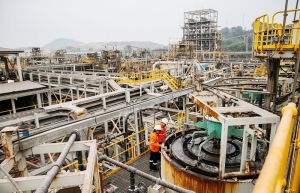Tungsten riches not yet in grip of giants
At the end of July, Samsung Electronics announced the first shipment of 3-nanometer semiconductors, the first of its kind worldwide. The move marks an important milestone in the race to develop the most advanced and efficient chip in the market.
 |
| Tungsten riches not yet in grip of giants, illustration photo/ freepik.com |
The advancement in the sophisticated chipmaking technology, which helped Samsung beat foundry rival TSMC of Taiwan, is expected to bring the group more customers looking for powerful chips that enable smaller, faster, and more efficient technology products.
TSMC and Samsung have been engaged in intense competition to overtake each other by introducing the most cutting-edge and effective chips to the market and gaining clients for contract chip manufacturing.
In the first quarter of this year, the worldwide foundry market was dominated by TSMC with 53.5 per cent of the market share, followed by Samsung with 16.3 per cent, according to industry tracker TrendForce.
Tungsten has several important applications in semiconductor fabrication. In an attempt to take advantage of this race, top tungsten-producing nations like Vietnam are hoping to use their material riches to help the top companies compete and beat each other.
In fact, Vietnam was the second-biggest tungsten producer globally last year, according to the United States Geological Survey (USGS). As reported by German data provider Statista, in 2021 China topped the rankings by producing 66,000 metric tonnes, with Vietnam second on 4,500 tonnes and Russia on 2,400 tonnes.
By 2040, the total demand for the rare mineral is expected to quadruple. Meanwhile, the mineral demand for electric vehicle batteries and battery storage will grow around 30-fold, according to the International Energy Agency.
However, groups like Masan High-Tech Materials (MHT) are yet to join the supply chain of Samsung in Vietnam. The Nui Phao mine in the northern province of Thai Nguyen is the leading asset of Masan Group, in which MHT is in charge of mining, processing, and export activities. In 2021, the total output of MHT’s tungsten increased by 97 per cent, while the company delivered net revenues of $581.5 million, up 86 per cent year on year.
Samsung always strictly controls information about the source of tungsten and does not discuss the limited supply of tungsten from China, as well as the pressure on sourcing the material to produce chips or batteries. Nevertheless, Vietnam is Samsung’s second-largest global production base.
Theoretically, analysts said, it is possible to supply a certain amount of tungsten from the Nui Phao mine to Samsung’s six manufacturing plants in Vietnam. This would help Samsung to increase the localisation rate of raw materials in the country. At the same time, it would also help Samsung reduce transportation costs when China is tightening the supply of tungsten to the world market and promoting the export of high-grade processed tungsten products.
MHT boasts several advantages. In particular, its open-pit mine helps lowers the rate of rock removal and labour costs. MHT, however, cannot compete with China in the supply of raw materials to multinational technology companies like Samsung in the domestic market. Currently, China’s consumption of concentrated tungsten products is growing faster than production, according to the USGS.
The Nui Phao mine has a lifespan of 20 years. Due to shrinking reserves, mining activities have to be conducted deeper and farther. Meanwhile, the mining rights of MHT will end in 2028. After the acquisition of the mine in 2013, Masan started commercial production in the following year. At that time, the global tungsten market experienced oversupply as China shut down many tungsten mines for environmental reasons. In 2022, MHT expects to achieve revenue of about $620-641 million.
According to the classification of the General Department of Geology of Vietnam under the Ministry of Natural Resources and Environment, Vietnam has discovered more than 5,000 mines and ore points containing about 60 different types of minerals. Mines of high-value minerals, such as copper, gold, tungsten, bismuth, and nickel-cobalt mostly have small reserves.
Tungsten is gradually running out after a long period of indiscriminate mining and selling of raw ore, said Nguyen Bao Linh, a researcher at the Institute of Mining-Metallurgy Science and Technology under the Ministry of Industry and Trade. “Tungsten ore is difficult to mine because of its complex composition. The Thien Ke mine in the northern province of Tuyen Quang for example, which is 24km west of Nui Phao, has to combine different mineral extraction methods to obtain tungsten of high quality,” Linh said.
 | Vietnam's tungsten supply chain asserts its global market position As the tungsten price increases, global manufacturers are now seeing that Vietnam has gradually emerged as the leading integrated supplier of advanced high-tech materials. |
 | Tungsten recycling in advanced battery technologies H.C. Starck Tungsten Powders, a subsidiary of Masan High-Tech Materials, has partnered with Nyobolt to develop high-performing, quick-charging, and eco-friendly Lithium-ion (Li-ion) battery products. |
What the stars mean:
★ Poor ★ ★ Promising ★★★ Good ★★★★ Very good ★★★★★ Exceptional
Related Contents
Latest News
More News
- Government moves to establish International Financial Centre (December 21, 2025 | 21:00)
- Vietnam's IFC to target global investment flows (December 21, 2025 | 18:00)
- Two national hospitals expand capacity with new facilities (December 20, 2025 | 09:00)
- Ha Tinh breaks ground on major Vingroup industrial and energy projects (December 19, 2025 | 18:24)
- EVN launches major power infrastructure projects nationwide (December 19, 2025 | 18:17)
- VAL inaugurates second production line to meet domestic animal feed demand (December 19, 2025 | 16:37)
- Sun Group pioneers urban tram system in Phu Quoc (December 19, 2025 | 15:00)
- Seven major projects launched to drive Hanoi’s next growth phase (December 19, 2025 | 14:00)
- Securing capital and efficiency for Vietnam’s 2026-2030 growth ambitions (December 17, 2025 | 10:00)
- Vietnam bucking trend in the global M&A landscape (December 16, 2025 | 14:20)

 Tag:
Tag:




















 Mobile Version
Mobile Version